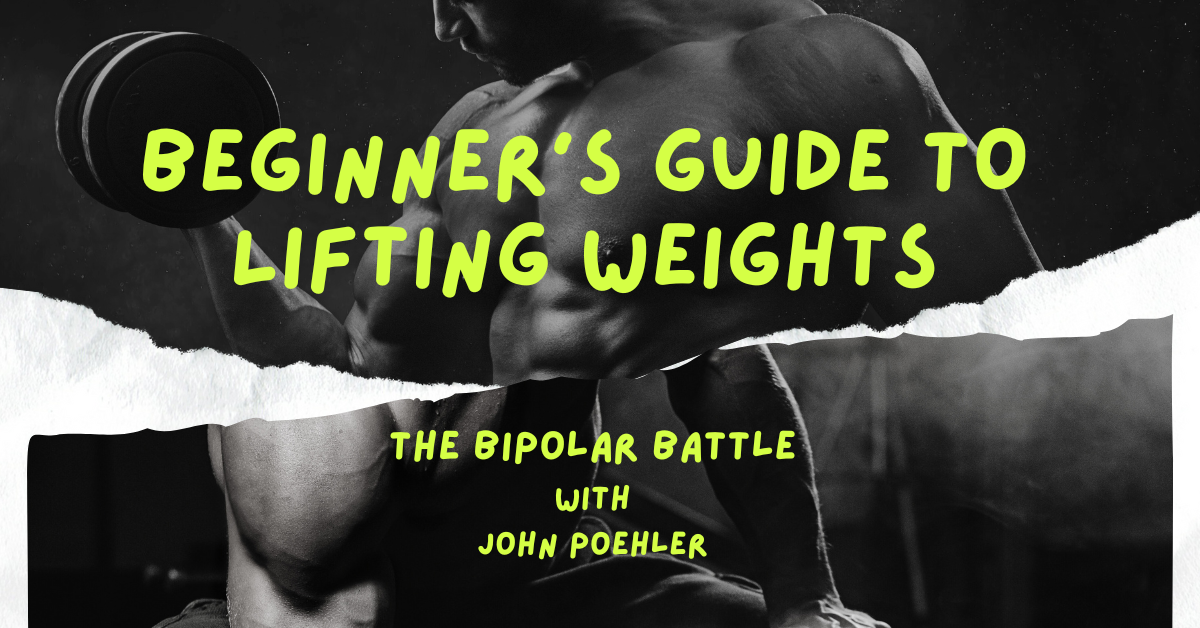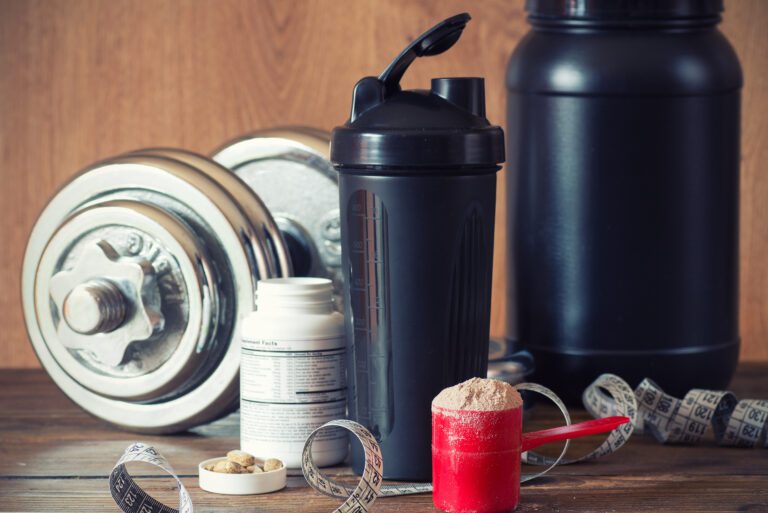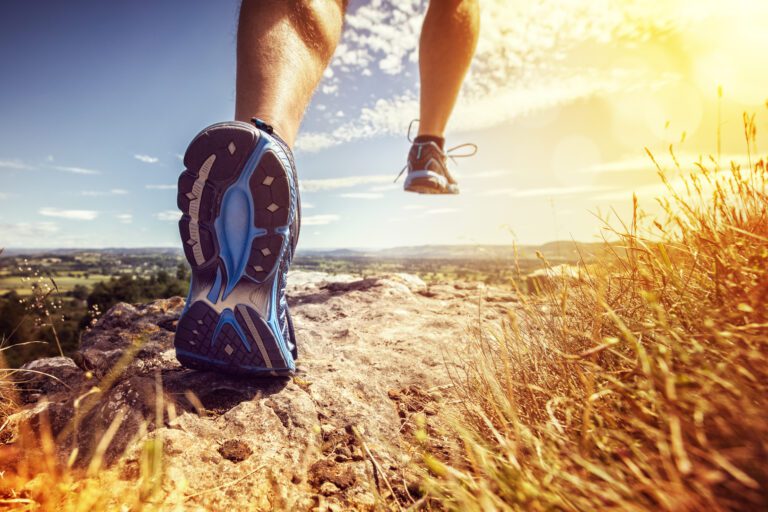Beginner’s Guide – How To Lift Weights And Eat Healthy
Lifting weights, or resistance training, is a form of exercise that everyone can benefit from. Personally, I love weightlifting and I make sure to get my workout in each day (with interspersed recovery days, of course).
Some benefits associated with lifting weights include (among others):
- Increased energy.
- Improved mood.
- Better sleep.
- Decreased cravings for certain foods.
- Muscle growth.
- Sharper memory.
- Whether you want to lose weight, gain muscle mass, tone up, or better both your mental and physical health, lifting weights can get you there.
If you are a newbie, you may wonder how to get started. Never fear – I have been lifting weights for years and was previously a personal trainer for close to 10 years. I would like to share my insights with you, from my experience, to get you on the road to success.
Before we get started, I need to make a quick disclaimer: Always speak with your doctor first, before starting a new workout program.
Weightlifting Terminology
If you already know the basic terms associated with weightlifting, you can skip this section. If you are new to the world of lifting weights, I highly suggest you read on to learn the basic terminology.
Repetition (Rep)
A rep is one full movement of an exercise, comprising both an eccentric and concentric contraction. For example, one repetition of a barbell bench press comprises of slowly bringing the bar down to your chest and then pushing it back up.
Set
The total number of reps you do, one after the other, makes up one set. For example, you may do one set of dumbbell bench presses consisting of eight total reps. After you complete that final eighth rep, your set is complete.
Dumbbell (DB)
You hold one dumbbell in your left hand and one in your right hand. Some exercises require you to only use one, while for others you need to use two.
Dumbbells can be adjustable, which offers greater flexibility if you are working out at home. They are convenient to use in my at-home gym because they do not take up much space.
Each dumbbell consists of one small bar with a connector on each end. The connectors secure the weighted plates in place. Then, I can add or subtract plates depending on how much weight I need to lift for a particular exercise.
Preset dumbbells are most commonly found in commercial gyms, but can also be purchased for at-home use. The preset dumbbells are typically set at a certain weight, such as 5 lbs., 7.5 lbs., 10 lbs., and so on. They take up more space because you need a separate set of dumbbells for each amount of weight you want to lift.
Barbell (BB)
A barbell is one long bar, on which you can load weighted plates on each side. It is also a piece of equipment most commonly used in commercial gyms.
A barbell setup takes up more space. Not only is the bar bigger, but the weighted plates you load on each side of the bar are larger the more you go up in weight. Plus, you need a place to rack the bar when you do an exercise, such as a bench press or squat.
Like adjustable dumbbells, the weighted plates come in different sizes, so you can increase the weight you lift as you get stronger.
An Olympic-sized barbell weighs 45 pounds.
Split
A split is the number of days in your workout program to exercise each major muscle group in your body. There are different variations of splits, mainly dependent on your goals and schedule. For example, with a three-day split, you would work out all the major muscle groups in your body over three days.
Guide – How To Lift Weights And Eat Healthy: The Foundation
There are a few fundamentals that will increase your likelihood of being successful in following a weightlifting schedule and, ultimately, reaching your goals.
Whatever goal you set for yourself, consistency is the key to getting you there.
Consistency is about following your workout program regularly. If you lift three days per week, make sure you get that time in. If you are running short on time, remember: doing something is ALWAYS better than doing nothing. It is better to get in part of your workout for the day than to skip it completely.
Life always seems to throw us a curve ball, right? I am used to my 30-45 minute workouts. However, if something comes up, and I cannot get my full workout in, I allow myself that flexibility. I make it a point to get through as much of the workout I can and not to skip a day. Even if I can only get half my workout in, that is okay.
Finding a workout program, whatever it ends up being for you, fosters an atmosphere of growth. As time goes on, and you work out consistently, it becomes second nature-almost like brushing your teeth! How often do you skip brushing your teeth? That same philosophy should transfer to your workouts. You want your workouts to feel like second nature.
Food As Fuel
As a disclaimer, I am not a registered dietician. The thoughts and suggestions I provide are based solely on my personal experience as both an exercise enthusiast and my nearly 10 years of working as a personal trainer.
Eating is a favorite pastime for many people, myself included. I love to eat meals with my family and friends and go out to eat on special occasions. That being said, I must adopt the proper perspective of food, so I can continue to reach my workout goals.
I look at food as fuel to run my body. Fuel gives me energy and a greater propensity for recovery. For my body to run efficiently, I need to make smart choices about what food I eat to fuel my body. After all, you cannot run an unleaded car on diesel fuel—it would destroy the engine!
I adopted my perspective on food by changing my approach to how I look at it. Instead of trying to find the “right” diet, I focus on making smart food choices day in and day out. Eating healthy is a change I made to my lifestyle. It is not a short-term fix but rather something I implement daily.
Not only do I watch what I eat and the amount, but I also focus on the macros that I consume—carbohydrates (carbs), protein, and fat.
Carbohydrates (Carbs)
Carbohydrates are necessary for energy. They come in two basic forms—simple and complex.
Complex carbs are slow-digesting. Since they take longer to digest, the sugar levels in your body remain relatively stable. Brown rice and sweet potatoes are examples of complex carbs.
Simple carbs are fast-digesting, and, because of this, they get into your bloodstream faster. There is an initial spike in your body’s sugar level, followed by a “crash.” Baked goods and treats are examples of simple carbs.
Have you ever eaten a bunch of sweets at one time and then felt exhausted afterward? That is the “carb crash” I am speaking about.
Protein
Protein makes up a large portion of your muscles. Plus, it helps to build and repair them. When you lift weights, you are essentially tearing and breaking down the muscles. Then, as they heal and rebuild, the muscles become stronger and more efficient at burning fat. It makes sense that as you engage in a regular weightlifting program, your body requires more protein intake to rebuild your muscles.
Increasing your protein intake is an important strategy to employ, especially if your goal is to lose weight or build muscle. As your body builds more muscle, it becomes more efficient at burning fat.
Fat
Fat helps to build and repair muscle, too, along with helping to synthesize carbohydrates. Your body needs healthy fats to function.
Healthy fats are more calorically dense and make you feel full longer than protein and carbs alone.
Calories
Each day, the human body needs a certain amount of energy, or calories, to function. This is called your basal metabolic rate (BMR).
Your BMR is the minimum amount of calories your body needs to breathe, digest food, pump your heart, and run all your other internal organs. If you were to just sit there and do nothing, your BMR would be the amount of calories your body needs to survive. Your age, gender, height, and weight are all considered when figuring out your BMR.
You must take in enough calories to hit your BMR each day. Anything less than that, and your body will slow down, and you will feel sluggish and unmotivated.
The amount of activity (or expenditure) you engage in each day also affects your daily caloric needs. The more active you are, the more energy (fuel) your body needs, and this increases your daily caloric intake.
The actual calculation to determine your exact BMR is rather complex. My suggestion is to use THIS ONLINE BMR CALCULATOR, or download an application on your phone. Once you get that target BMR number, you can manipulate the kinds of food you eat and your portion sizes throughout the day to reach your goals.
Next, we will look at how your goals help to determine the amount of calories you need each day.
Calculating Calories
Your workout goals will determine how many total calories you need to take in each day (or total daily caloric expenditure), in addition to your BMR (that we learned about above).
When you lift weights, your body burns calories. The same goes for any other physical activity you do. To determine the amount of calories burned, you can use an online tool or an app like NOOM. There, you can determine the total amount of calories used, based on the type of exercise and duration. Your total daily caloric expenditure is equal to your BMR, plus the activity you engage in during the day.
If my goal is to lose weight, I take in fewer calories each day than my total daily caloric expenditure, while still making sure not to go below the calories for my BMR threshold.
If my goal is to build muscle mass, I take in more calories each day than my total daily caloric expenditure.
Perhaps my goal is to just maintain. If that is the case, I focus on taking in the same amount of calories as my daily caloric expenditure.
To further define your total caloric needs for the day, you need to look specifically at the macros in the foods you eat and do some simple math.
Each macro stores a certain amount of energy, or calories. The breakdown is as follows:
- There are 4 calories in each gram of carbohydrate.
- There are 4 calories in each gram of protein.
- There are 9 calories in each gram of fat.
When you know the amount of carbs, protein, and fat in a particular food, you can take the total gram weight of the macro in question, and then multiply it by the amount of calories in the corresponding macro. Next, add them up, and you have the total number of calories for the food in question.
This process can be quite tedious when doing it by hand. Instead, you could set up a spreadsheet, plug in the numbers, and the spreadsheet will automatically calculate it for you. Another option is to use an app on your phone to track your macros and calories. I highly recommend the NOOM App.
Portion Size
When you read the nutritional information on a food label, you will notice “serving size.” Most of the time, a serving is weighed in grams.
When I weigh my foods, I like using a digital scale.
As part of my perspective viewing food, I make sure to always use moderation. Not only do I watch what I eat, but I also pay close attention to the portion sizes I consume. For example, if I want donuts for breakfast, I eat just one. Even if I am tempted to eat the whole box, I only allow myself the one donut.
In terms of how many times you should eat per day, I find it is easier on my body to eat 5-6 smaller meals (or snacks), as opposed to three large ones. I battle with stomach issues, and the smaller meals alleviate the stress that larger portion-sized meals have on my digestive system.
My mantra for making smart food choices is: When in doubt, leave it out!
An Alternative For Portion Control
Sometimes, trying to keep track of macros and calories can be overwhelming. This is especially true if you are also starting a new exercise plan. If you find yourself in this position, you can simplify things.
Instead of tracking all the numbers and doing the math, you can estimate. As my foundation, I eat 5-6 times per day with about 2-3 hours between each of those meals. At each meal, I try to consume both carbohydrates and protein. I also add some healthy fats throughout the day, but not at every meal. My suggestion is to shoot to add some at two meals.
Use your hand to help guide your portion size. Eat a fistful size of carbs and a palm size of protein. Remember, you want to choose slow-digesting carbs, such as brown rice, sweet potatoes, and oatmeal. For protein, you want lean choices, such as turkey, chicken, eggs, Greek yogurt, and quinoa.
For meals, I add in healthy fats, usually about a tablespoon size. Examples of healthy fats include avocados, nuts, and peanut butter.
Remember, too: Do not forget your vegetables! Using this strategy, you can eat as many raw vegetables as you want throughout the day. That is, as long as you do not add butter, cheese, and other toppings to them.
The Importance Of Water
Almost three-quarters of our body is made up of water. Therefore, it stands to reason that you should be drinking lots of water throughout the day. Your water intake should increase when you are lifting weights and leading an active lifestyle.
I keep a water bottle with me, and I try to drink and refill it at least five times throughout the day.
If you feel even slightly dehydrated, then your body will not function optimally. You may feel nauseous, sluggish, and achy and be unable to concentrate, among other bothersome symptoms.
Proper hydration flushes the toxins out of your body and will help you to feel refreshed.
Goals For Lifting Weights
What is your main goal for lifting weights? Is it to build muscle mass? Perhaps tone up? Maybe just to get healthier?
I find it much more advantageous to have a goal to focus on. After all, that goal helps to shape a short-term and long-term workout program design.
Your main goal will help guide you in how you train with weights. There are three distinct modes of training that you can employ to lift weights.
1) Endurance
The optimal rep range in endurance training is 12+ reps per set. At this higher rep range, you require less weight to lift and shorter periods of rest. Rest periods between sets are typically 15-30 seconds.
Endurance training is great to focus on if your goal is to tone up.
2) Hypertrophy
The optimal rep range in hypertrophy training is 8-10 reps per set, with about a minute to 90 seconds ofrest between sets. To get in that optimal range for reps, you will lift heavier weights, compared to endurance training.
Hypertrophy training will give your muscles that fuller look. This mode of training is about muscle growth and is great to focus on if your goal is to build muscle mass.
3) Strength
The optimal rep range for strength training is from 1 to 6 reps per set. Since this mode of training is focused on lifting heavier weights, you will need longer rest periods in between sets. Shoot for at least one minute and thirty seconds of rest between sets, but generally you will need a longer break.
This type of training is great to focus on if your goal is to build strength. You want to lift the heaviest weight possible, without injury. If you are a beginner, you should not start in this mode of training, because it is easy to injure yourself.
As you become a more experienced weightlifter, your workout program will employ all three different modes of training, all to varying degrees of duration and intensity.
Cardiovascular (Cardio)
Cardio is an aerobic activity that elevates your heart rate. Getting cardio in each week is important, no matter what your weight-training goal is. However, your weightlifting goal will help you determine the frequency and intensity of your cardio workouts.
Cardio helps to keep your heart and lungs healthy. Examples include running, walking, biking, hiking, and swimming, to name a few. You don’t need to be a marathon runner (although, if you are, that is quite alright), but cardio is an important component of an overall workout program. I’ll discuss more about the frequency of cardio in your workout program in the following sections.
Guide – How To Lift Weights And Eat Healthy: Program Design
First, we will go over the types of exercises you can perform for each of the major muscle groups in the body. If you have a question about how to perform a certain exercise or the proper form, you can always go to YouTube for an example of the exercise in question.
For most of the following listed exercises, you can use dumbbells, barbells, or bands. Also, these lists are not “all-exhaustive.”
Chest:
- Chest Press
- Incline Chest Press
- Decline Chest Press
- Chest Flyes
Back:
- Pullups
- Rows
- Upright Rows
- Supermans
Shoulders:
- Military/Shoulder Press
- Side Raises
- Front Raises
- Sitting Reverse Flyes
Biceps (Bis):
- Curls
- Hammer Curls
- Spiderman Curls
- Preacher Curls
Triceps (Tris):
- Triceps Extensions
- Skull Crushers
- Triceps Kickbacks
- Triceps Pushdowns
Legs:
- Squats
- Deadlifts
- Leg Curls
- Lunges
When creating a workout program, you want to make sure NOT to work out the same muscle two days in a row. You need to rest your muscles so they can rebuild and recover. Otherwise, you risk over-training, which can lead to injury.
Besides the types of foods you eat, rest is just as important to your workout program as the actual weightlifting workout itself.
Goal: Lose Weight
In addition to lifting weights, you want to make sure cardio is a component to your workout program.
Starting out, you will focus on training in endurance mode.
As I mentioned above, you will want to make sure you are in a calorie deficit for the day when your goal is to lose weight.
Goal: Tone Up
In addition to lifting weights, you want to make sure cardio is a component to your workout program.
Starting out, you will focus on training in hypertrophy mode.
In terms of calorie intake, you want to shoot to break even for the day. The total calories you consume should equal the amount you expend (or use).
Goal: Gain Muscle Mass
If gaining muscle mass is your goal, the frequency of cardio in your program will be less than that of the other goals.
Starting out, you will focus on training in hypertrophy mode.
To gain muscle mass, you want to make sure you are in a caloric surplus for the day. In other words, you need to consume more calories than the total of your BMR and daily activity combined.
Tips To Start Your Workout Program
When you first start lifting weights, expect your body to feel sore as it gets used to the new stress you are putting on it. That being said, you should never feel like you are in pain. If you ever feel pain, whether it is sharp or otherwise, immediately stop lifting and speak with your doctor or personal trainer, if you have one.
When starting out, it is better to err on the side of caution and ease into your new workout program. Start out with lighter weights and slowly build from there. The last thing you want to do is injure yourself before you get into the rhythm of your workout routine.
Along the same line of thinking, it is important that you take your time performing each exercise and focus on your form. Do each repetition slowly and controlled, while making sure to do the same with your breathing.
There is a natural tendency to hold your breath when performing a weightlifting exercise. It may be helpful to count your breathing along with the repetition you are doing, with a 3-1-3 cadence. Breathe in for 3 seconds, hold for a second, and then breathe out.
Finding Time To Work Out
Choose a time of day to do your workout when you are motivated and where it fits in with your schedule. Personally, I like to work out first thing in the morning, so I make sure to get it done, and I don’t have to worry about doing it later in the day.
Others like to work out after they are done with work or school. Maybe you want to get your workout in on a break during the day. There is no hard-and-fast rule to apply on when to lift weights. The important thing is that you get it done-and try to be as consistent as possible.
Again, as a beginner, I suggest easing into your workout program. It is frustrating if you overdo it, and then you have to take a week off because you are too sore, or if you get injured.
The Flow Of Your Workout
There is a general rule of thumb when going through a workout. Also, this does not apply just to weight training but also engaging in any kind of physical activity, for that matter.
Pre-Workout
About 15-20 minutes prior to your workout, it is important to get some nourishment. Experiment to see how eating and drinking make you feel during your workout. You do not need as much protein as your post-workout refuel, but you need some all the same. You can eat a light snack, drink a protein shake, or even try a pre-workout drink.
Warmup
Warming up your body gets the blood flowing, so you can optimize your workout. Most importantly, you want to take measures to prevent injury. Shoot for a warmup of about five minutes or so.
Stretch
Once you have increased your heart rate from your warm-up, you should get about five minutes or so of stretching. Stretching needs to be a priority for injury prevention. However, you cannot stretch without a warmup-which would make you prone to muscle tears and other injuries.
Work Out
The optimal time frame for a weight-training workout (after your pre-workout nourishment, warm-up, and stretching session) is from 30 to 45 minutes and no more than one hour.
Post-Workout (Cool Down And Recovery)
Immediately following your workout, consume protein with a bit of carbohydrate. I generally drink a protein shake with about 25 grams of protein containing a small amount of carbs. The carbs should be fast-acting, so you can get nourishment into your system as quickly as possible. Most protein drinks already contain a small portion of carbs, so make sure to double-check the nutrition label.
When I work out at the gym, I bring a shaker with me, containing my pre-measured protein powder. Then, when I am done with my workout, I add some cold water and shake vigorously. Voila, I have my post-workout drink.
There is a small window of about 30 minutes after the completion of your workout when you need to get protein in your system. Getting protein within that optimal time frame will optimize your recovery and replenish your energy stores so you do not feel tired and wiped out.
Generally speaking, I drink my protein shake while I cool down. If I am at the gym, I walk on the treadmill and sip down my protein shake while I cool down.
Make sure to cool down for five minutes or longer, depending on the intensity of the workout. Doing a slow walk will help decrease your heart rate gradually down to a normal range.
Guide – How To Lift Weights And Eat Healthy: Beginner Workout Schedule
The example workout programs in this section can be tweaked based on your own schedule, time constraints, and the weightlifting exercises you want to focus on.
You can find two different workout splits below. I customized them so you can follow the workout routine at home. A list of the suggested equipment I recommend can be found in my article, “The Ultimate Guide How To Build An At-Home Gym On a Budget.”
Remember, this is a guide, and you can switch around the exercises to the ones you want, as long as they work out the targeted muscle group for that specific day. Feel free to review the exercise list above for ideas.
The suggested rep range is how much weight you can lift for the stated range or reps. For example, if the range is from 8 to 10 reps, find a weight that you can do within that range. If you lose your form, then the weight is too much, and you should reduce it. If you get through 10 reps, and you could do more than that, increase the weight in your next workout.
3-Day Split (Monday/Wednesday/Friday)
With this 3-day split, you will work out two muscle groups per lifting day. At the end of the week, you will have worked out your entire body one time.
I have separate days set aside for “cardio.” However, you can also do cardio immediately following your weightlifting workout. If you do that, just make sure to cool down and recover after you have completed both your weight-training workout and cardio.
Monday
Chest/Triceps
- DB Chest Presses
- DB Flyes
- Triceps Pushdowns
- Triceps Kickbacks
Tuesday
Cardio
Wednesday
Back/Biceps
- Pullups
- DB Rows
- DB Curls
- DB Hammer Curls
Thursday
Cardio
Friday
Legs/Shoulders
- DB Squats
- DB Deadlifts
- DB Military Press
- DB Side Raises
- DB Front Raises
Saturday
Cardio
Sunday
Rest/Active Recovery
4-Day Split (Monday/Tuesday/Thursday/Friday)
With a 4-day split, you will perform exercises to work out your upper body on one day and your lower body on another. There are other options to this split, but this one will get you started.
The upper body muscles you will focus on are the chest, back, shoulders, biceps, and triceps. The lower body muscles you will focus on are the quadriceps, hamstrings, glutes, and calves. At the end of the week, you will have worked out your entire body two times.
I have separate days set aside for cardio. However, you can also do cardio immediately following your weightlifting workout. If you do that, just make sure to cool down and recover after you have completed both your weight-training workout and cardio.
Monday
Upper Body
- DB Chest Press
- Pullups
- DB Military Press
- DB Bicep Curls
- DB Triceps Kickbacks
Tuesday
Lower Body
- DB Squats
- DB Deadlifts
- DB Walking Lunges
- DB Sumo Squats
- DB Calf Raises
Wednesday
Cardio
Thursday
Upper Body
- Incline DB Chest Press
- DB Rows
- DB Side Raises
- DB Hammer Curls
- Band Triceps Pushdowns
Friday
Lower Body
- DB Squats
- DB Deadlifts
- Wall Sit (For Time)
- DB Goblet Squats
- DB Calf Raises
Saturday
Cardio
Sunday
Rest/Active Recovery

Myths
There are several myths in the fitness world that I would like to dispel. There are actually quite a few, but I would like to go over some of the common ones and give you the correct information.
Myth #1
Women who lift weights bulk up.
Truth
Many of my past female clients questioned if they would up bulk if they lifted weights. More than once, I had a client say, “John, I just want to get that lean and toned look. I don’t want to bulk up like those bodybuilders.”
Women do not produce testosterone like men do. The only way for women to “bulk up” the way men do is through the use of testosterone treatments.
Myth #2
To lose weight, you need to eat fat-free food.
Truth
It seems reasonable that if you eat something without fat, you won’t put on weight, right? Wrong. As we discussed previously, you put on weight when you have a surplus of calories over your daily caloric expenditure of activity plus your BMR combined.
Remember, fat is more calorically dense than, say, protein or carbohydrates. However, eliminating it will not get you to your goals faster. Instead, this may inhibit your progress, because you need fat in your daily intake of food for your body to function at an optimal level.
Myth #3
Lifting more often and doing longer workouts will get you to your goal faster.
Truth
When you lift weights, you need proper rest and recovery to rebuild them. If you do not allow enough time for recovery, you can over-train your muscles. So trying to lift more often and for longer periods can inhibit your progress.
The optimal time to work out is 30-45 minutes. In addition, you need rest (or active rest) days to properly recover from your weight-training workouts.
Myth #4
You can target a specific spot on your body to lose weight.
Truth
The popular belief that I have heard for years, and still do today, is that if you do enough crunches, you will get a six-pack. You can indeed strengthen your abs or whichever muscle you want to strengthen, but targeting a specific area will not make you lose weight in that area.
The way to show the muscles on your body, in addition to your weight-training workouts, is to focus on losing weight. Making smart food choices will help you accomplish that goal.
As the human body loses weight, it will slowly take it from areas all over the body. There is no specific targeted location.
I hope you have found ”Beginner’s Guide – How To Lift Weights And Eat Healthy” beneficial. Please share your comments and questions below. I would love to hear what has helped you with your own experience and what you have learned, as well.







